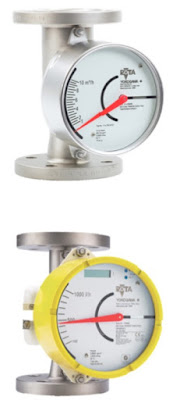 |
| Rotameter (Yokogawa) |
Rotameters have diverse industrial processing applications that range from simple to sophisticated. The devices are easy to install, require no electrical connection, and provide direct flow rate reading. They provide fail-safe flow rate in different situations.
The post will highlight the workings of rotameters, also known as a variable area flow meter.
Rotameters: An Overview
Invented by German inventor Karl Kueppers in 1908, rotameters measure the volumetric flow rate of liquids and gases. The device was so named because it functions by rotating in a tube.
Important elements of a rotameter include the tube and the float.
The tube is fixed vertically and liquid is fed from the bottom. The fluid is fed from the bottom that travels upward and exits from the top. The float remains at the bottom when no liquid is present and rises upward when fluid enters the tube.
The float inside the tube moves in proportion to the rate of fluid flow and the area between the tube wall and the float. When the float moves upward, the area increases while the differential pressure decreases. A stable position is reached when the upward force exerted by the fluid is equal to the weight of the float. A scale mounted on the tube records the flow rate of the liquid.
Every float position shows a specific flow rate for the viscosity and density of a liquid. The device helps in determining the flow rate by matching the position of the float to a scale on the rotameter. The flow can be adjusted manually using a built-in valve.
Types of Rotameters
Rotameters can be categorized by the type of tube. A sharp metering edge is located on the float from where the reading is observed by a scale on the tube. The connections and end fittings of the various types of rotameters are different.
Glass Rotameter
 |
| Glass rotameters (Yokogawa) |
The basic glass rotameters consist of borosilicate glass tube while the float is made of either glass, plastic, or stainless steel. The most common combination is a glass tube and metal float. This is suitable for a measure the flow rate of liquid of low to medium temperature and pressure.
Flow rate is determined by the spring and piston combination of the rotameter. The materials and fittings should be chosen as per the temperature and pressure of the liquid.
Metal Rotameter
Metal tube rotameters are another type that is suitable for temperatures and pressures beyond the glass tubes. They are generally manufactured of stainless steel, aluminum, and brass. The piston position is determined by the mechanical and magnetic followers that can be read from the outside of
the tube.
the tube.
 |
| Metal rotameter (Yokogawa) |
Industrial Applications of Rotameters
The use of rotameter extends across different industries. The device is extensively used in industries since its an economical way to measure a range of flow rates in almost any conditions.
Sample Process Analysis
Rotameters are widely used in sample process analysis. A device with 4 to 20 mA output is used to measure the flow of a sample system. Monitoring the flow rate ensures that the system does not become plugged that could result in big problems. The device can indicate when the flow starts to drop so that the maintenance crew can address the problem before it results in major damage.
Transport of Liquid Natural Gas
LNG must be re-gasified during transport to prevent system overpressure that could cause major damage to the storage system. Rotameter can measure the flow rate of vented vapor even at very low temperature. They are ideal for determining the LNG flow rate during transport due to being low cost and providing an accurate reading.
Rotating Equipment
Rotameters are also used in measuring the flow of liquid in large rotating equipment. They are used to measure the flow rate of dry gas, coolants, lubricant fluids to ensure safe operations. The device helps in monitoring of coolant flows a lube oil. The flow can be measured continuously due to the use of 4— 20 mA transmitting rotameters.
Benefits of Rotameters
Rotameters, or variable area flow meters are cost-effective for use in different industrial applications. The price and low maintenance of the device contribute to significant savings for industrial concerns.
Another advantage of rotameters is that no external power is required. They are mechanical device and no external power source is required to measure the flow rate. This makes it possible for the device to be used in remote and hazardous areas where installing an external power supply can be costly.
The design of the rotameter allows not the only the measurement of fluid flow but also determine the quality of the liquid. The crew members can see whether the fluid is dirty thereby requiring a change of filter. They can also know whether bubbles are present in the liquid and also whether the liquid is of the correct color.
Rotameters can be installed along with other flow measuring devices to ensure accurate readings. The device can continuously determine an accurate flow rate. They are simple to install and easy to maintain. Just connect the process line to rotameter’s inlet and outlet pipe. That’s why they are commonly used in many industries where it’s critical to accurately measure the flow rate of the liquid.
Contact Power Specialties, Inc. with any questions regarding the use of rotameters. Call them them at (816) 353-6550 or visit https://powerspecialties.com.